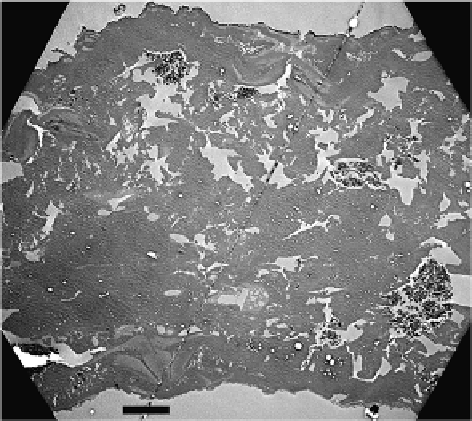Geology Reference
In-Depth Information
Fig. 3.4
TEM section of portion of leaf of fossil
Pinus
, which, like the angiosperms, is not recog-
nisable in terms of modern leaf tissues. Scale bar 10
μ
m
Castanea
one leaf has open texture and one closed. The closed texture leaf is one
quarter of the thickness (c.48 vs. 12
μ
m,
Populus
) to half the thickness (c. 37 vs.
18
m,
Castanea
) of the open texture leaf. Therefore the closed versus open texture
may be related to differential compaction during fossilisation. Whereas the section of
Populusalba
1 (Fig.
3.3b
) with open layering might be interpreted as merely a
decompacted version of
Populus alba
2 (Fig.
3.3c
) such a simple explanation cannot
account for the difference in the
Castanea
as the open textured specimen is not
layered. The differences between the open and closed textures may therefore refl ect
different physical or chemical properties of the organic matter, the latter being
unlikely as all leaves have been shown to have a similar chemical composition or
minor heterogeneities in burial conditions.
Taking the full spectrum of leaf preservation observed in the Ardeche material
(13 specimens studied)
Populusalba
1 and
Quercushispanica
1 are unique. No other
specimen shows the open lamellar structure of the former and no other specimen
shows cellular structure like the latter. All other specimens show either open textures
like
Q. hispanica
2 and
C. vesca
2 or closed textures like
P. alba
2 and
C. vesca
1.
The single gymnosperm leaf studied
Pinus
(Fig.
3.4
) has an internal organisation
combining areas of open and closed texture but lacking any cell-like structure or
layering. Electron dense (dark) granular patches are iron pyrites fi lling spaces in the
open texture. Some relatively electron lucent (lighter) organic material is present.
These microscopical observations show that in only one exceptional specimen
does the internal organisation of the fossil leaf show any resemblance to modern
leaves. In all other cases the organic material is not recognisable as leaf tissue.
There is no link between preservation state and leaf taxon but a 'preservational
continuum' can be seen from open organisation with cell structure (Fig.
3.3f
) through
μ

Search WWH ::

Custom Search